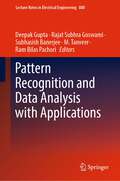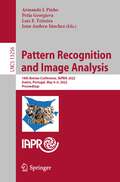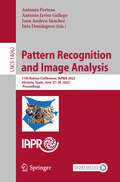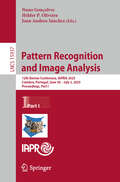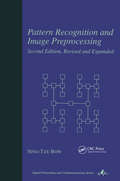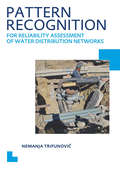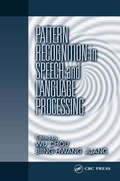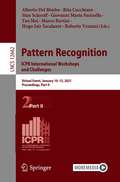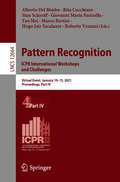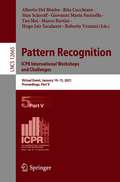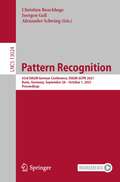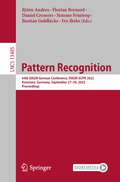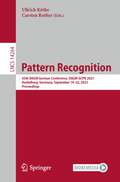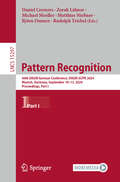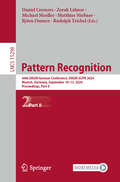- Table View
- List View
Pattern Recognition and Data Analysis with Applications (Lecture Notes in Electrical Engineering #888)
by M. Tanveer Ram Bilas Pachori Deepak Gupta Rajat Subhra Goswami Subhasish BanerjeeThis book covers latest advancements in the areas of machine learning, computer vision, pattern recognition, computational learning theory, big data analytics, network intelligence, signal processing and their applications in real world. The topics covered in machine learning involves feature extraction, variants of support vector machine (SVM), extreme learning machine (ELM), artificial neural network (ANN) and other areas in machine learning. The mathematical analysis of computer vision and pattern recognition involves the use of geometric techniques, scene understanding and modelling from video, 3D object recognition, localization and tracking, medical image analysis and so on. Computational learning theory involves different kinds of learning like incremental, online, reinforcement, manifold, multi-task, semi-supervised, etc. Further, it covers the real-time challenges involved while processing big data analytics and stream processing with the integration of smart data computing services and interconnectivity. Additionally, it covers the recent developments to network intelligence for analyzing the network information and thereby adapting the algorithms dynamically to improve the efficiency. In the last, it includes the progress in signal processing to process the normal and abnormal categories of real-world signals, for instance signals generated from IoT devices, smart systems, speech, videos, etc., and involves biomedical signal processing: electrocardiogram (ECG), electroencephalogram (EEG), magnetoencephalography (MEG) and electromyogram (EMG).
Pattern Recognition and Image Analysis: 10th Iberian Conference, IbPRIA 2022, Aveiro, Portugal, May 4–6, 2022, Proceedings (Lecture Notes in Computer Science #13256)
by Armando J. Pinho Petia Georgieva Luís F. Teixeira Joan Andreu SánchezThis book constitutes the refereed proceedings of the 10th Iberian Conference on Pattern Recognition and Image Analysis, IbPRIA 2022, held in Aveiro, Portugal, in May 2022. The 54 papers accepted for these proceedings were carefully reviewed and selected from 72 submissions. They deal with document analysis; medical image processing; biometrics; pattern recognition and machine learning; computer vision; and other applications.
Pattern Recognition and Image Analysis: 11th Iberian Conference, IbPRIA 2023, Alicante, Spain, June 27–30, 2023, Proceedings (Lecture Notes in Computer Science #14062)
by Joan Andreu Sánchez Antonio Pertusa Antonio Javier Gallego Inês DominguesThis book constitutes the refereed proceedings of the 11th Iberian Conference on Pattern Recognition and Image Analysis, IbPRIA 2023, held in Alicante, Spain, in June 27–30, 2023. The 56 papers accepted for these proceedings were carefully reviewed and selected from 86 submissions. They deal with Machine Learning, Document Analysis, Computer Vision, 3D Computer Vision, Computer Vision Applications, Medical Imaging & Applications, Machine Learning Applications.
Pattern Recognition and Image Analysis: 12th Iberian Conference, IbPRIA 2025, Coimbra, Portugal, June 30 – July 3, 2025, Proceedings, Part I (Lecture Notes in Computer Science #15937)
by Joan Andreu Sánchez Nuno Gonçalves Hélder P. OliveiraThe two volume set LNCS 15937 + 15938 constitutes the proceedings of the 12th Iberian Conference on Pattern Recognition and Image Analysis, IbPRIA 2025, which took place in Coimbra, Portugal, during June 30–July 3, 2025. The 67 full papers included in the proceedings were carefully reviewed and selected from 115 submissions. They were organized in topical sections as follows: Part I: Computer vision; faces, body, fingerprints and biometrics; machine and deep learning; explainability, bias and fairness in DL; Part II: Natural language processing; biomedical applications; and other applications.
Pattern Recognition and Image Analysis: 12th Iberian Conference, IbPRIA 2025, Coimbra, Portugal, June 30 – July 3, 2025, Proceedings, Part II (Lecture Notes in Computer Science #15938)
by Joan Andreu Sánchez Nuno Gonçalves Hélder P. OliveiraThe two volume set LNCS 15937 + 15938 constitutes the proceedings of the 12th Iberian Conference on Pattern Recognition and Image Analysis, IbPRIA 2025, which took place in Coimbra, Portugal, during June 30–July 3, 2025. The 67 full papers included in the proceedings were carefully reviewed and selected from 115 submissions. They were organized in topical sections as follows: Part I: Computer vision; faces, body, fingerprints and biometrics; machine and deep learning; explainability, bias and fairness in DL; Part II: Natural language processing; biomedical applications; and other applications.
Pattern Recognition and Image Preprocessing (Signal Processing And Communications Ser. #Vol. 14)
by Sing T. BowDescribing non-parametric and parametric theoretic classification and the training of discriminant functions, this second edition includes new and expanded sections on neural networks, Fisher's discriminant, wavelet transform, and the method of principal components. It contains discussions on dimensionality reduction and feature selection; novel computer system architectures; proven algorithms for solutions to common roadblocks in data processing; computing models including the Hamming net, the Kohonen self-organizing map, and the Hopfield net; detailed appendices with data sets illustrating key concepts in the text; and more.
Pattern Recognition for Reliability Assessment of Water Distribution Networks: UNESCO-IHE PhD Thesis
by N. TrifunovicThis study investigates the patterns that describe reliability of water distribution networks focusing to the node connectivity, energy balance, and economics of construction, operation and maintenance. A number of measures to evaluate the network resilience has been developed and assessed to arrive at more accurate diagnostics of regular and irreg
Pattern Recognition in Computational Molecular Biology
by Jason T. Wang Mourad Elloumi Albert Y. Zomaya Costas IliopoulosA comprehensive overview of high-performance pattern recognition techniques and approaches to Computational Molecular Biology This book surveys the developments of techniques and approaches on pattern recognition related to Computational Molecular Biology. Providing a broad coverage of the field, the authors cover fundamental and technical information on these techniques and approaches, as well as discussing their related problems. The text consists of twenty nine chapters, organized into seven parts: Pattern Recognition in Sequences, Pattern Recognition in Secondary Structures, Pattern Recognition in Tertiary Structures, Pattern Recognition in Quaternary Structures, Pattern Recognition in Microarrays, Pattern Recognition in Phylogenetic Trees, and Pattern Recognition in Biological Networks. Surveys the development of techniques and approaches on pattern recognition in biomolecular data Discusses pattern recognition in primary, secondary, tertiary and quaternary structures, as well as microarrays, phylogenetic trees and biological networks Includes case studies and examples to further illustrate the concepts discussed in the book Pattern Recognition in Computational Molecular Biology: Techniques and Approaches is a reference for practitioners and professional researches in Computer Science, Life Science, and Mathematics. This book also serves as a supplementary reading for graduate students and young researches interested in Computational Molecular Biology.
Pattern Recognition in Speech and Language Processing (Electrical Engineering And Applied Signal Processing Ser.)
by Wu Chou Biing Hwang JuangOver the last 20 years, approaches to designing speech and language processing algorithms have moved from methods based on linguistics and speech science to data-driven pattern recognition techniques. These techniques have been the focus of intense, fast-moving research and have contributed to significant advances in this field.Pattern Reco
Pattern Recognition, Tracking and Vertex Reconstruction in Particle Detectors (Particle Acceleration and Detection)
by Rudolf Frühwirth Are StrandlieThis open access book is a comprehensive review of the methods and algorithms that are used in the reconstruction of events recorded by past, running and planned experiments at particle accelerators such as the LHC, SuperKEKB and FAIR. The main topics are pattern recognition for track and vertex finding, solving the equations of motion by analytical or numerical methods, treatment of material effects such as multiple Coulomb scattering and energy loss, and the estimation of track and vertex parameters by statistical algorithms. The material covers both established methods and recent developments in these fields and illustrates them by outlining exemplary solutions developed by selected experiments. The clear presentation enables readers to easily implement the material in a high-level programming language. It also highlights software solutions that are in the public domain whenever possible. It is a valuable resource for PhD students and researchers working on online or offline reconstruction for their experiments.
Pattern Recognition. ICPR International Workshops and Challenges: Virtual Event, January 10–15, 2021, Proceedings, Part II (Lecture Notes in Computer Science #12662)
by Marco Bertini Giovanni Maria Farinella Hugo Jair Escalante Alberto Del Bimbo Stan Sclaroff Rita Cucchiara Tao Mei Roberto VezzaniThis 8-volumes set constitutes the refereed of the 25th International Conference on Pattern Recognition Workshops, ICPR 2020, held virtually in Milan, Italy and rescheduled to January 10 - 11, 2021 due to Covid-19 pandemic. The 416 full papers presented in these 8 volumes were carefully reviewed and selected from about 700 submissions. The 46 workshops cover a wide range of areas including machine learning, pattern analysis, healthcare, human behavior, environment, surveillance, forensics and biometrics, robotics and egovision, cultural heritage and document analysis, retrieval, and women at ICPR2020.
Pattern Recognition. ICPR International Workshops and Challenges: Virtual Event, January 10–15, 2021, Proceedings, Part IV (Lecture Notes in Computer Science #12664)
by Marco Bertini Giovanni Maria Farinella Hugo Jair Escalante Alberto Del Bimbo Stan Sclaroff Rita Cucchiara Tao Mei Roberto VezzaniThis 8-volumes set constitutes the refereed of the 25th International Conference on Pattern Recognition Workshops, ICPR 2020, held virtually in Milan, Italy and rescheduled to January 10 - 11, 2021 due to Covid-19 pandemic. The 416 full papers presented in these 8 volumes were carefully reviewed and selected from about 700 submissions. The 46 workshops cover a wide range of areas including machine learning, pattern analysis, healthcare, human behavior, environment, surveillance, forensics and biometrics, robotics and egovision, cultural heritage and document analysis, retrieval, and women at ICPR2020.
Pattern Recognition. ICPR International Workshops and Challenges: Virtual Event, January 10–15, 2021, Proceedings, Part V (Lecture Notes in Computer Science #12665)
by Marco Bertini Giovanni Maria Farinella Hugo Jair Escalante Alberto Del Bimbo Stan Sclaroff Rita Cucchiara Tao Mei Roberto VezzaniThis 8-volumes set constitutes the refereed of the 25th International Conference on Pattern Recognition Workshops, ICPR 2020, held virtually in Milan, Italy and rescheduled to January 10 - 11, 2021 due to Covid-19 pandemic. The 416 full papers presented in these 8 volumes were carefully reviewed and selected from about 700 submissions. The 46 workshops cover a wide range of areas including machine learning, pattern analysis, healthcare, human behavior, environment, surveillance, forensics and biometrics, robotics and egovision, cultural heritage and document analysis, retrieval, and women at ICPR2020.
Pattern Recognition: 43rd DAGM German Conference, DAGM GCPR 2021, Bonn, Germany, September 28 – October 1, 2021, Proceedings (Lecture Notes in Computer Science #13024)
by Juergen Gall Christian Bauckhage Alexander SchwingThis book constitutes the refereed proceedings of the 43rd DAGM German Conference on Pattern Recognition, DAGM GCPR 2021, which was held during September 28 – October 1, 2021. The conference was planned to take place in Bonn, Germany, but changed to a virtual event due to the COVID-19 pandemic.The 46 papers presented in this volume were carefully reviewed and selected from 116 submissions. They were organized in topical sections as follows: machine learning and optimization; actions, events, and segmentation; generative models and multimodal data; labeling and self-supervised learning; applications; and 3D modelling and reconstruction.
Pattern Recognition: 44th DAGM German Conference, DAGM GCPR 2022, Konstanz, Germany, September 27–30, 2022, Proceedings (Lecture Notes in Computer Science #13485)
by Daniel Cremers Simone Frintrop Björn Andres Florian Bernard Bastian Goldlücke Ivo IhrkeThis book constitutes the refereed proceedings of the 44th DAGM German Conference on Pattern Recognition, DAGM GCPR 2022, which was held during September 27 – 30, 2022.The 37 papers presented in this volume were carefully reviewed and selected from 78 submissions. They were organized in topical sections as follows: machine learning methods; unsupervised, semi-supervised and transfer learning; interpretable machine learning; low-level vision and computational photography; motion, pose estimation and tracking; 3D vision and stereo; detection and recognition; language and vision; scene understanding; photogrammetry and remote sensing; pattern recognition in the life and natural sciences; systems and applications.
Pattern Recognition: 45th DAGM German Conference, DAGM GCPR 2023, Heidelberg, Germany, September 19–22, 2023, Proceedings (Lecture Notes in Computer Science #14264)
by Carsten Rother Ullrich KötheThis book constitutes the proceedings of the 45th Annual Conference of the German Association for Pattern Recognition, DAGM-GCPR 2023, which took place in Heidelberg, Germany, during September 19-22, 2023. The 40 full papers included in these proceedings were carefully reviewed and selected from 76 submissions. They were organized in topical sections as follows: Segmentation and action recognition; 3D reconstruction and neural rendering; Photogrammetry and remote sensing; Pattern recognition in the life sciences; Interpretable machine learning; Weak supervision and online learning; Robust models.
Pattern Recognition: 46th DAGM German Conference, DAGM GCPR 2024, Munich, Germany, September 10–13, 2024, Proceedings, Part I (Lecture Notes in Computer Science #15297)
by Daniel Cremers Zorah Lähner Michael Moeller Matthias Nießner Björn Ommer Rudolph TriebelThis 2-volume set LNCS 15297-15298 constitutes the refereed proceedings of the 46th Annual Conference of the German Association for Pattern Recognition, DAGM-GCPR 2024, held in Munich, Germany, during September 10-13, 2024.The 44 full papers included in these proceedings were carefully reviewed and selected from 81 submissions. They are organized in these topical sections:Part I: Clustering and Segmentation; Learning Techniques; Medical and Biological Applications; Uncertainty and Explainability.Part II: Modelling of Faces and Shapes; Image Generation and Reconstruction; 3D Analysis and Sythesis; Video Analysis; Photogrammetry and Remote Sensing.
Pattern Recognition: 46th DAGM German Conference, DAGM GCPR 2024, Munich, Germany, September 10–13, 2024, Proceedings, Part II (Lecture Notes in Computer Science #15298)
by Daniel Cremers Zorah Lähner Michael Moeller Matthias Nießner Björn Ommer Rudolph TriebelThis 2-volume set LNCS 15297-15298 constitutes the refereed proceedings of the 46th Annual Conference of the German Association for Pattern Recognition, DAGM-GCPR 2024, held in Munich, Germany, during September 10-13, 2024.The 44 full papers included in these proceedings were carefully reviewed and selected from 81 submissions. They are organized in these topical sections:Part I: Clustering and Segmentation; Learning Techniques; Medical and Biological Applications; Uncertainty and Explainability.Part II: Modelling of Faces and Shapes; Image Generation and Reconstruction; 3D Analysis and Sythesis; Video Analysis; Photogrammetry and Remote Sensing.
Pattern Recognition: 5th Asian Conference, ACPR 2019, Auckland, New Zealand, November 26–29, 2019, Revised Selected Papers, Part I (Lecture Notes in Computer Science #12046)
by Liang Wang Wei Qi Yan Shivakumara Palaiahnakote Gabriella Sanniti di BajaThis two-volume set constitutes the proceedings of the 5th Asian Conference on ACPR 2019, held in Auckland, New Zealand, in November 2019. The 9 full papers presented in this volume were carefully reviewed and selected from 14 submissions. They cover topics such as: classification; action and video and motion; object detection and anomaly detection; segmentation, grouping and shape; face and body and biometrics; adversarial learning and networks; computational photography; learning theory and optimization; applications, medical and robotics; computer vision and robot vision; pattern recognition and machine learning; multi-media and signal processing; and interaction.
Pattern Recognition: 6th Asian Conference, ACPR 2021, Jeju Island, South Korea, November 9–12, 2021, Revised Selected Papers, Part II (Lecture Notes in Computer Science #13189)
by Qingshan Liu Christian Wallraven Hajime NagaharaThis two-volume set LNCS 13188 - 13189 constitutes the refereed proceedings of the 6th Asian Conference on Pattern Recognition, ACPR 2021, held in Jeju Island, South Korea, in November 2021. The 85 full papers presented were carefully reviewed and selected from 154 submissions. The papers are organized in topics on: classification, action and video and motion, object detection and anomaly, segmentation, grouping and shape, face and body and biometrics, adversarial learning and networks, computational photography, learning theory and optimization, applications, medical and robotics, computer vision and robot vision.
Pattern Recognition: A Quality of Data Perspective
by Witold Pedrycz Wladyslaw HomendaA new approach to the issue of data quality in pattern recognition Detailing foundational concepts before introducing more complex methodologies and algorithms, this book is a self-contained manual for advanced data analysis and data mining. Top-down organization presents detailed applications only after methodological issues have been mastered, and step-by-step instructions help ensure successful implementation of new processes. By positioning data quality as a factor to be dealt with rather than overcome, the framework provided serves as a valuable, versatile tool in the analysis arsenal. For decades, practical need has inspired intense theoretical and applied research into pattern recognition for numerous and diverse applications. Throughout, the limiting factor and perpetual problem has been data—its sheer diversity, abundance, and variable quality presents the central challenge to pattern recognition innovation. Pattern Recognition: A Quality of Data Perspective repositions that challenge from a hurdle to a given, and presents a new framework for comprehensive data analysis that is designed specifically to accommodate problem data. Designed as both a practical manual and a discussion about the most useful elements of pattern recognition innovation, this book: Details fundamental pattern recognition concepts, including feature space construction, classifiers, rejection, and evaluation Provides a systematic examination of the concepts, design methodology, and algorithms involved in pattern recognition Includes numerous experiments, detailed schemes, and more advanced problems that reinforce complex concepts Acts as a self-contained primer toward advanced solutions, with detailed background and step-by-step processes Introduces the concept of granules and provides a framework for granular computing Pattern recognition plays a pivotal role in data analysis and data mining, fields which are themselves being applied in an expanding sphere of utility. By facing the data quality issue head-on, this book provides students, practitioners, and researchers with a clear way forward amidst the ever-expanding data supply.
Pattern Theory: The Stochastic Analysis of Real-World Signals
by David Mumford Agnès DesolneuxPattern theory is a distinctive approach to the analysis of all forms of real-world signals. At its core is the design of a large variety of probabilistic models whose samples reproduce the look and feel of the real signals, their patterns, and their variability. Bayesian statistical inference then allows you to apply these models in the analysis o
Patterns in Past Settlements: Geospatial Analysis of Imprints of Cultural Heritage on Landscapes (Springer Remote Sensing/Photogrammetry)
by M.B. RajaniThis book is an introduction to a new branch of archaeology that scrutinises landscapes to find evidence of past human activity. Such evidence can be hard to detect at ground-level, but may be visible in remote sensing (RS) imagery from aerial platforms and satellites. Drawing on examples from around the world as well as from her own research work on archaeological sites in India (including Nalanda, Agra, Srirangapatna, Talakadu, and Mahabalipuram), the author presents a systematic process for integrating this information with historical spatial records such as old maps, paintings, and field surveys using Geographic Information Systems (GIS) to gain new insights into our past. Further, the book highlights several instances where these insights are actionable -- they have been used to identify, understand, conserve, and protect the fragile remnants of our past. This book will be of particular interest not only to researchers in archaeology, history, art history, and allied fields, but to governmental and non-governmental professionals working in cultural heritage protection and conservation.
Patterns in the Machine: A Software Engineering Guide to Embedded Development
by John T. Taylor Wayne T. TaylorDiscover how to apply software engineering patterns to develop more robust firmware faster than traditional embedded development approaches. In the authors’ experience, traditional embedded software projects tend towards monolithic applications that are optimized for their target hardware platforms. This leads to software that is fragile in terms of extensibility and difficult to test without fully integrated software and hardware. Patterns in the Machine focuses on creating loosely coupled implementations that embrace both change and testability. This book illustrates how implementing continuous integration, automated unit testing, platform-independent code, and other best practices that are not typically implemented in the embedded systems world is not just feasible but also practical for today’s embedded projects. After reading this book, you will have a better idea of how to structure your embedded software projects. You will recognize that while writing unit tests, creating simulators, and implementing continuous integration requires time and effort up front, you will be amply rewarded at the end of the project in terms of quality, adaptability, and maintainability of your code. What You Will Learn Incorporate automated unit testing into an embedded projectDesign and build functional simulators for an embedded projectWrite production-quality software when hardware is not availableUse the Data Model architectural pattern to create a highly decoupled design and implementationUnderstand the importance of defining the software architecture before implementation starts and how to do itDiscover why documentation is essential for an embedded projectUse finite state machines in embedded projects Who This Book Is For Mid-level or higher embedded systems (firmware) developers, technical leads, software architects, and development managers.
Patterns of Interaction: Computational Design Across Scales (SpringerBriefs in Architectural Design and Technology)
by Pia Fricker Toni KotnikThis book is a reflection on contemporary computational design thinking at the intersection of architecture, urban design, and landscape architecture, in a time marked by complex challenges like climate change, urbanization and population growth. Based on a critical rethinking of the notion of ground and the relation between the manmade and the natural environment, an understanding of architecture as regenerative practice is proposed. It aims at a built environment as landscape, at an architecture of prosthetic nature. The design approach is illustrated by a number of design experiments conducted within a studio setting and complemented by a series of conversations with leading experts on sustainable design and landscape architecture.
